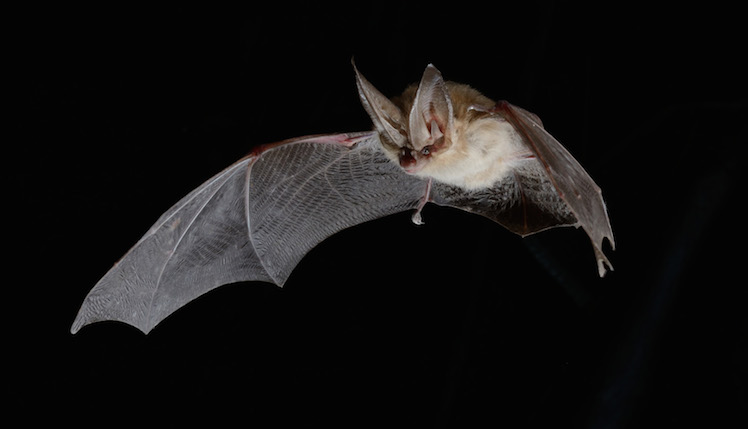Some bat species lost sophisticated sonar ability as they evolved

Posted January 09, 2017
- All bats species' inner ears develop in same way at early stages
- But some types of bats do not subsequently develop ability to echolocate
- Investigators examined inner ears of different species of foetal and newborn bats
All bat species once possessed the ability to make high-pitched sounds and then make an acoustic image of the returning echoes – a technique known as echolocation – but some species lost this capacity as they evolved.
Researchers have found that the inner ears of all bat species, even those that now cannot use echolocation, develop in the very first stages of life in a way that is required to facilitate the sonar ability.
But the subsequent rapid growth and development that would provide the mammals with the physical characteristics to utilise the technique is missing in some species.
The new research was published in (opens in a new window)Nature Ecology & Evolution.
Pictured top: A Townsend's big-eared bat, which uses echolocation (Credit: Professor Brock Fenton)
The study suggests the ability to echolocate evolved just once and was subsequently lost in some species, rather than evolving several times, as some scientists believe – therefore all bats once had the ability to use sound waves in this sophisticated way.
Professor Emma Teeling, UCD School of Biology and Environmental Science, who is also Founding Director of the Centre for Irish Bat Research, and colleagues from (opens in a new window)Shenyang Agricultural University in China, carried out the research.
Bats can navigate by sending out high-frequency sonar signals, produced in their voice boxes, and then they listen for returning echoes, which they detect in their inner ears – a technique known as laryngeal echolocation. The ability enables bats to navigate and hunt, even in complete darkness. But some bat species, such as fruit bats, cannot echolocate.
Pictured: Professor Emma Teeling, UCD School of Biology and Environmental Science, who co-authored the study.
Genetic evidence suggests bats that use laryngeal echolocation have not evolved from a single evolutionary group. Given the scarcity of bat fossils, to date it has also not been possible to determine from the fossil record alone whether the sonar trait evolved from just one evolutionary group.
Instead of looking at fossils or even the inner ear of adults bats, the researchers tested the alternative theories by looking at how the inner ear develops in foetal and newborn bats.
Cochleae are tiny bones that bats use to differentiate minuscule differences in the pitch of returning echoes.
Using x-ray microradiographs, the investigators studied the cochlear development of seven species of bats – two fruit bats that do not use laryngeal echolocation, and five other bats that use laryngeal echolocation. They also examined five species of other non-echolocating animals, including cats and rats.
Rapid development
The researchers observed the rapid development of the cochleae in early foetal stages in all the bat species, but this same level of rapid growth was not present in the other mammals. The fruit bats’ cochleae were similar in size to other bats and were approximately 65 per cent bigger than other mammals.
“As the fruit bats develop, their cochlear growth significantly slowed down so that by the time they were adults their cochleae were similarly sized to the other non-echolocating mammals,” said Professor Emma Teeling.
“In the past, when evolutionary biologists examined the size of the cochlea in the non-echolocating fruit bat adults, they looked like all other non-echolocating mammals, indicating that they may never have had the ability to echolocate,” said Professor Teeling.
“For the first time we explored the development of the cochlea in non-adult bats and this revealed that all bats, including the species that do not echolocate start off with an extremely large cochlea which is indicative of echolocation capabilities.”
The authors concluded that ancestors of fruit bats most likely had the ability to echolocate and that the large foetal cochleae are a sort of living fossil of the fruit bat’s ancient echolocating ancestors.
Professor Teeling is now involved in (opens in a new window)BAT1K – a large global consortium of individuals committed to sequencing the genomes of all living species of bat to chromosome level assemblies. She said she hopes the project will help scientists to uncover precisely how the echolocation trait evolved.
The paper is entitled (opens in a new window)Prenatal development supports a single origin of laryngeal echolocation in bats.
By: Jamie Deasy, digital journalist, UCD University Relations
UCD academics on The Conversation
- Opinion: The leap year is February 29, not December 32 due to a Roman calendar quirk – and fastidious medieval monks
- Opinion: Nigeria’s ban on alcohol sold in small sachets will help tackle underage drinking
- Opinion: Nostalgia in politics - Pan-European study sheds light on how (and why) parties appeal to the past in their election campaigns






